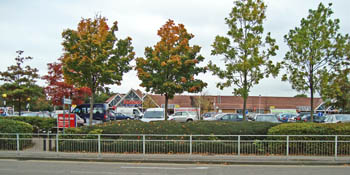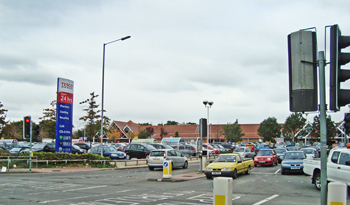Acute. Later, geriatric
The Potters Bar and District Hospital replaced the Cottage Hospital. It opened in August 1939 with a dedication service for its foundation stones. The stone for the men's ward was unveiled by the Earl and Countess of Stafford, Mrs McNish Porter and Mr A.B. and Miss L.J. Sanderson; that for the private wards by Mr I.F.L. Elliott; for the women's ward by Cllr and Mrs H. Shillitoe; and that for the children's ward by the 13-year-old twins of the donor of the site, Mr. H.W. Tilbury. The first patient was admitted on 15th August.
Potters Bar Urban District Council recognised the Hospital, giving it a farthing (a tenth of 1p) rate, which gave it an income of £100 a year. The Middlesex County Council gave 10 guineas (£10.50) a year, but Hertfordshire County Council gave no financial assistance.
Pleasant to look at, in ample grounds, the building was approached by a wide driveway lined with summer flowering trees. At the top of the driveway was a circular flower bed planted with roses donated by the Furzefield Women's Institute (two tall conifers in the flower bed would be decorated with fairy lights at Christmas). Flower beds were also inset into the lawns of the Hospital. To the left of the driveway were a small car park and a delivery area for kitchen and hospital supplies; to the right was the Out-Patients Department and another small car park.
The Hospital itself was an H-shaped single-storey red brick building well set back from Mutton Lane. It was two-thirds larger than the Cottage Hospital it replaced. It had 42 beds which were managed by the local GPs. Twelve of the beds were in private patient rooms, which cost 6 guineas (£6.30) a week.
The East Wing housed the operating
theatre, three wards and the small Out-Patients Department, which had a
waiting room, a consulting room and a casualty theatre. At the
far end were the children's wards - the one nearest the kitchen side
had cots, while the other was for older children. Irene Jones
Ward, for female surgical and gynaecological patients had 11 beds
(during WW2 these were doubled to 22 beds).
The West Wing contained the kitchen and service departments, as well as three wards. The private ward was named after Mr Tilbury, the baker whose shop was on the corner of the High Street and Mutton Lane, and who had donated the land for the new Hospital. It contained 5 single rooms and 2 double rooms and was used mainly for seriously ill patients. In addition, there were 4 amenity beds. The male ward, with 6 medical and 6 surgical beds, was named after Cllr Shillitoe, who had been the Chairman of the Hospital Committee from 1932 to 1944. There was also a side ward with 2 beds. The kitchen was large and airy. It was shut off from the rest of the Hospital so that no noise or smells penetrated, but it was still conveniently placed for the delivery of food to the wards.
A very small upper storey, with a view over the Hertfordshire
countryside, contained sleeping quarters for the nurses and domestic
servants. It had been constructed to eventually allow two more
storeys to be added when funds allowed. However, the outbreak of WW2
held up the Building Appeal and the plans for the extension and the
building of a Nurses' Home had to be shelved.
During WW2 the Hospital became part of the Emergency Medical Service, with 49 beds. Besides local casualties, patients were transferred from the London Hospital to Potters Bar. When the Alert sounded, patients were wheeled out of their wards, still in their beds, into a protected passage. The average length of stay of an in-patient was 9 days.
Fund-raising became difficult during the war as many subscribers had enlisted, but the Hospital managed to feed patients and staff at an annual cost of under £20 per individual due to the generous donations of food gifts from supporters. Nearly 200 tons of waste paper was collected and sold to raise £800 towards the cost of a Nurses' Home.
In January 1945 a V2 rocket exploded in Southgate Road, causing much damage, but the Hospital was so busy that the patients had to be transferred to other hospitals.
In 1948 the Hospital joined the NHS with 50 beds. It was under the control of the Barnet Group Hospital Management Committee, part of the North West Metropolitan Regional Hospital Board.As the Hospital had no Nurses' Home the nurses were billeted out, making it difficult to attract staff. The average bed occupancy was only 19 out of 50. The Committee decided to close 9 private rooms and use them instead as staff accommodation.
In 1949 the Committee acquired a large house a mile away, Little Heath Wood House, for use as a Nurses' Home. Newly equipped and furnished, this opened in April 1950, thus returning the accommodation in the Hospital to private patient use. The Hospital then had 2 private patient rooms and 4 amenity beds. The charge for a private room was 6 guineas (£6.30) for a resident of Potters Bar and 8 gns (£8.40) for a non-resident.
A new 6-bedded convalescent ward was also added to the East Wing. It was also used as a post-operative ward. (It had been intended to use this space to house an X-ray unit, but this was not finally installed until 1975; until then patients attended Barnet General Hospital for X-ray examination.) The Hospital then had 56 beds, including private patient rooms.
By 1955 there were 17 GPs on the staff and a Resident Senior House Officer had been appointed.
In 1959 a Day Room was built for use by ambulant patients. Furnished with comfortable easy chairs, foot stools, occasional tables and a TV set, it had been built and equipped with the help of the League of Friends, who contributed £3,750 towards the costs. The room had large picture windows and two French doors. There was a well-stocked library and a variety of board games.
By 1964 the Hospital had a Casualty Department and an Out-Patients Department, where clinics were held by medical, surgical, gynaecological, ear, nose and throat (ENT), chest and blood specialists. The West Wing contained a small ward with 5 beds - named Charles and Anne Ward, after Prince Charles and Princess Anne.
In 1967, despite great public protest, the Casualty Department closed. Shillitoe Ward was upgraded, with the 2-bedded side ward incorporated into the main ward, but the Hospital was threatened with change of use from acute to geriatric care.
In 1968 the Hospital had 56 beds - 17 for male and 19 for female patients, 11 for children and 9 private patient rooms. The second floor had never been built and the Hospital had no X-ray Department, nor Pathology Laboratory, but a mobile X-ray Unit visited when needed. It was decided that the children's ward in the East Wing was too big, so this was partitioned to accommodate 3 geriatric patients and 8 children. (It was later made into one ward with 11 beds for geriatric or long-stay patients and named Oakmere Ward, after the private estate which now contains the eastern part of Potters Bar.)
In May 1969 the Nurses' Home at Little Heath Wood House closed. By this time most staff lived out and the Home had become too expensive to maintain. The few remaining residents moved to a house opposite the Hospital.
In 1973 new staff quarters opened to the left of the main drive. The bungalow-style building had been built using money from the Sanderson Trust. A new Day Room also opened; Oakmere Ward had been slightly reduced by one bed space to accommodate the new extension.
In 1974, following a major NHS reorganisation, the Hospital came under the control of the Barnet Area Health Authority, part of the North West Thames Regional Health Authority. Charles and Anne Ward closed in the same year and the room was extended (with the incorporation of the Sisters' Sitting Room) to accommodate patients with chest disease transferred from Clare Hall Hospital, which closed in March 1975.
In 1982, after another reorganisation of the NHS, the Hospital became part of the Barnet District Health Authority, who planned to upgrade the operating theatres at Barnet General Hospital. It proposed to do this by closing the surgical units in the smaller hospitals in its group, that is, at Finchley Memorial Hospital and Potters Bar. An action committee was immediately formed in Potters Bar to prevent this. A petition was sent to the Chairman of the Health Authority, but to no avail. In March 1985 the operating theatres were closed and the equipment quickly removed.
The Hospital became a geriatric hospital with 52 beds in 1985. In 1986 the resident doctor's apartment was converted into an Assessment Flat, where patients undergoing rehabilitation following a stroke were retrained for everyday activities in the kitchen and so on. Two occupational therapists were employed in this unit. In 1989 the Physiotherapy Department moved into the converted operating theatre space, thus providing more room in the Out-Patients Department.
In 1990 the Hospital was transferred to the control of the Community Health Services Unit.
In the same year it was reported in the local press that the retailer Tesco was interested in buying the site of the Hospital for £8.5m. It proposed to build a new purpose-built hospital on the 2-acre site of Howgate House in Barnet Road. The land swap was agreed by the North West Thames Regional Health Authority, despite an acrimonious campaign by the local residents.
Now part of the Barnet Healthcare NHS Trust (later renamed NHS Barnet), the Hospital closed in January 1995 when the new 2-storey Potters Bar Community Hospital opened in Barnet Road.
Present status (October 2008)
The site now contains a Tesco supermarket.
The Nurses' Home, Little Heath Wood House, is now Gresley Court.

The Tesco supermarket in Mutton Lane (above and below).

Ottley B, Warren B 1995 Potters Bar Hospital (1884-1948). Journal of the Potters Bar and District Historical Society 9, 1-20.
Ottley B 1996 Potters Bar's second hospital (1939-1995). Journal of the Potters Bar and District Historical Society 10, 1-8.
www.british-history.ac.uk
www.cnplus.co.uk
www.pbhistory.co.uk
Return to home page